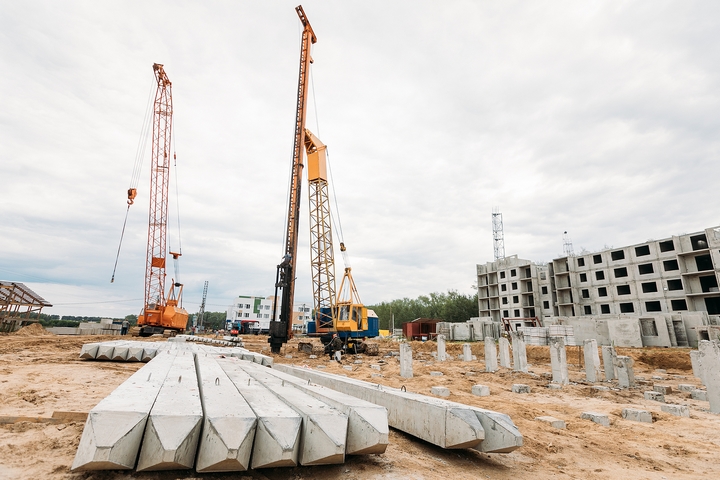
10 Types of Deep Foundation in the Construction Industry
In construction, foundation is everything. Without a solid foundation, everything else will crumble and fall before you know it. There are a ton of different foundation types, many of which are considered deep foundations. Deep foundations have to go a little bit deeper into the ground than regular foundations either because the soil is inadequate, there is water present, or the building is extremely tall, large, heavy, and/or asymmetrical.
Deep foundations are designed to disperse the weight and the load of the superstructure so that it maintains good form over time. Below are the ten types of deep foundation commonly found in the construction industry:
Type #1: Basement foundations

Basements offer the opportunity for the entire structure to sit directly on top of the strong soil below the surface. In this case, the structure evades having to deal with the inadequate upper soil. Instead, the entire area will be excavated to the appropriate depth, and the structure will be built at that level.
This is a beneficial solution for all parties, as this deep foundation type offers added space to the structure, and can be used for a variety of purposes.
Type #2: Caisson foundations

Caissons is a type of deep foundation often used on work sites that take place at a body of water. For instance, many bridges use them as foundations. They can also be used in dam construction and ship repair. The concept of a caisson is simply a hollow box that is sunk down to its desired location, and is subsequently filled with concrete, creating a sturdy base.
These types of deep foundation are beneficial because they are not heavy to transport, as they aren’t full of concrete yet. So, caissons are easily transported, and sometimes even floated, to their desired location and then concrete is added to keep them in place.
Type #3: Pier foundations

There are two main types of pier foundations: Drilled caissons and concrete piers. Typically, a pier foundation is popular for construction occurring in coastal regions, and it has economic, environmental, and labour benefits. It is a highly beneficial method for regions where floods are a concern.
Type #4: Drilled caissons

There are three types of drilled caissons: concrete caissons with an enlarged bottom; hollow steel pipes filled with concrete; and hollow steel pipes with steel reinforcements filled with concrete. These types of deep foundation are always cast-in-situ to some degree.
Type #5: Masonry or concrete piers

If usable soil is available within five metres or less of the surface, it is likely that concrete piers will be used. They can differ in size and shape in order to best meet the needs of the project and environment.
Type #6: Hollow box foundation

Also called buoyancy rafts foundations, these are created specifically to be a sort of floating structure to support the superstructure. This gives the soil a break, so to speak, so there isn’t as much pressure being applied to it. The key is to remember that the purpose of a foundation is to disperse the load so as not to apply too much weight directly to one area, or directly to the soil.
That is exactly what the hollow box foundation does here, and they are especially useful in areas where the inadequate or soft soil goes very deep, thus rendering other types of foundations inefficient.
Type #7: Pile foundations

Pile foundations install long, cylinders made of steel, concrete, or wood deep into the ground. These types of foundations are usually managed by pile drivers and other similar equipment. There are other kinds of pile foundations like sheet foundations that are installed deep in the ground but that are not cylindrical. However, the most commonly used methods usually use the long, cylindrical poles.
Type #8: Driven pile foundations

There are a couple of different ways that can be used to install the piles into the ground. Driven is very common, but also very loud. Pile hammers are used to pound the pile repeatedly until it reaches the desired depth. During this process, the soil below the pile is pushed out of the way and compacted against the other nearby soil. This can be very beneficial on certain projects and in certain types of soil.
Type #9: Built-in-situ piles

In construction, built-in-situ means built in place. These piles are manufactured directly in the spot where they will remain, rather than being manufactured elsewhere and transported to the project site. For these piles, the soil is excavated from the spot, creating a deep hole. Reinforcements are installed as needed, and then concrete is poured into the hole to fill it.
Type #10: Micropiles

These piles are typically created from a steel casing, and they are extremely strong but usually no bigger than 10 inches in diameter. Their small size allows them to be used when space is of the essence, while still being highly efficient at transferring a superstructure’s load. They are a form of cast-in-situ pile, and are filled with cement after they have been installed. They may also have steel reinforcement bars threaded throughout them for extra strength. Some other names for micropiles include pin piles, minipiles and needle piles.

